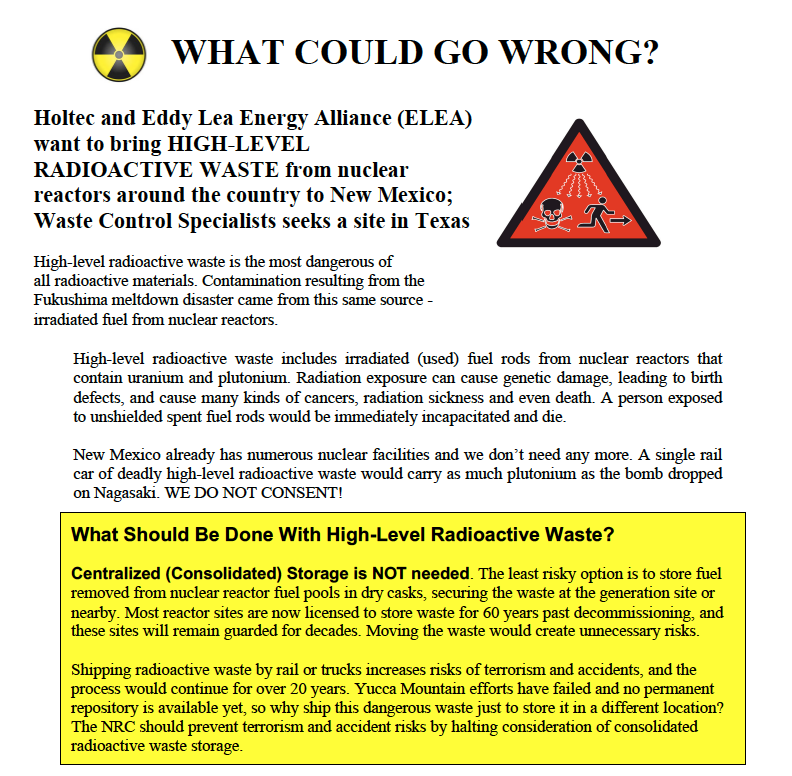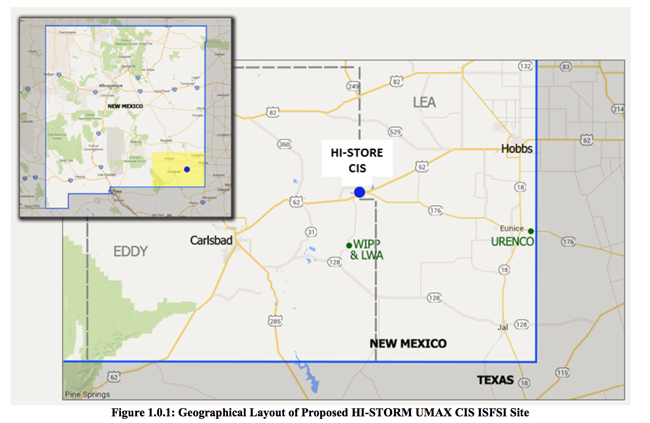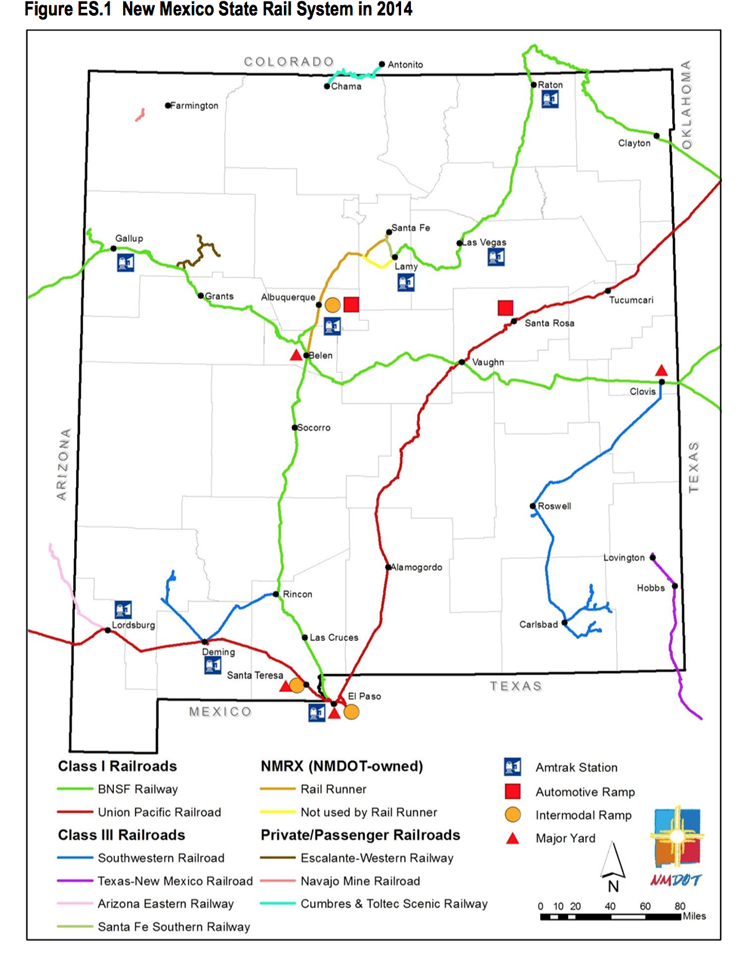New Mexico governor says no to high-level nuclear waste
June 7, 2019

ALBUQUERQUE, N.M. (AP) — New Mexico’s governor said Friday she’s opposed to plans by a New Jersey-based company to build a multibillion-dollar facility in her state to temporarily store spent nuclear fuel from commercial reactors around the U.S.
In a letter to U.S. Energy Secretary Rick Perry, Gov. Michelle Lujan Grisham said the interim storage of high-level radioactive waste poses significant and unacceptable risks to residents, the environment and the region’s economy.
She cited the ongoing oil boom in the Permian Basin, which spans parts of southeastern New Mexico and West Texas, as well as million-dollar agricultural interests that help drive the state’s economy.
New Mexico Is Divided Over The ‘Perfect Site’ To Store Nation’s Nuclear Waste
April 11, 2019

Nathan Rott/NPR
Thirty-five miles out of Carlsbad, in the pancake-flat desert of southeast New Mexico, there’s a patch of scrub-covered dirt that may offer a fix — albeit temporarily — to one of the nation’s most vexing and expensive environmental problems: What to do with our nuclear waste?
Despite more than 50 years of searching and billions of dollars spent, the federal government still hasn’t been able to identify a permanent repository for nuclear material. No state seems to want it.
So instead, dozens of states are stuck with it. More than 80,000 metric tons of spent nuclear fuel, a still-radioactive byproduct of nuclear power generation, is spread across the country at power plants and sites in 35 states.
The issue has dogged politicians for decades. Energy Secretary Rick Perry recently described the situation as a “logjam.” But some hope that this remote, rural corner of New Mexico may present a breakthrough.
Nuclear Regulators Search For Temporary Storage Facility In New Mexico
April 30, 2019
Private companies are proposing solutions to store the nation’s nuclear waste. The U.S. Nuclear Regulatory Commission is considering one storage site in New Mexico’s desert.
AILSA CHANG, HOST:
Nearly 100,000 tons of nuclear waste are piling up around the country. It wasn’t supposed to be this way. The federal government decided decades ago that it made sense to consolidate the waste at one permanent location, but no place seems to want it. So now nuclear regulators are considering proposals for temporary storage. NPR’s Nathan Rott checked out one such site in southeast New Mexico.
NATHAN ROTT, BYLINE:
When I asked for directions to the proposed interim nuclear storage facility, I got a few answers. The private company that wants to build it sent me GPS coordinates. A mayor in support of the project told me to drive to the county line and look north. Jason Shirley, a city councilman in Carlsbad, told me to drive 35 miles out of town, pull off on a dirt road and from there…
Holtec arrives at City Council
August 22, 2018
Citizens share opposition or ask city to remain neutral

The city of Roswell’s General Services Committee lent their ears to citizen opinions on the proposed Holtec International Project to store nuclear waste in between Carlsbad and Hobbs.
Around 30 people gathered into the large conference room at City Hall on Wednesday afternoon for an hour and a half meeting. The agenda included the Holtec project as a non-action item; no formal action was taken by the city at Wednesday’s meeting.
Chairman Councilor Savino Sanchez made a preamble asking the public to maintain decorum and remain respectful during the speeches. Committee members Jacob Roebuck and Angela Moore were present and Councilors Jeanine Corn Best, Judy Stubbs and Caleb Grant sat in the audience.
Discussions on Holtec facility continue amid concerns
Aug. 16, 2018
An opinion issued by New Mexico Attorney General Hector Balderas suggested New Mexico will have a limited role in licensing a proposed facility to store high-level nuclear waste near Carlsbad and Hobbs.
New Mexico Sen. Jeff Steinborn (D-36), who chairs the New Mexico Radioactive and Hazardous Waste Committee, said Balderas’ opinion was informative but did not preclude lawmakers from continuing to ask hard questions about the project.
TAKE ACTION!
To download a petition you can use to gather signatures:
News and Videos

- “We Don’t Want It “Says Group Concerned about Potential Radioactive Waste Impacts on Health, Safety and Existing Industries
Press Release 04/30/18
News Stories:
- New Mexico governor says no to high-level nuclear waste
Associated Press 6/7/19 - Federal nuclear board nixes request for hearing on New Mexico waste facility
Santa Fe New Mexican 5/7/19 - New Mexico Is Divided Over The ‘Perfect Site’ To Store Nation’s Nuclear Waste
NPR 4/11/19 - Nuclear Regulators Search For Temporary Storage Facility In New Mexico
NPR 4/30/19 - Spent nuclear waste burial halted at San Onofre until NRC can probe ‘near miss’ with canister
Orange County Register 8/24/18 - Holtec arrives at City Council
Roswell Daily Record 08/22/18 - Discussions on Holtec facility continue amid concerns
Albuquerque Journal 08/16/18 - Las Cruces council votes down nuclear storage facility
Albuquerque Journal 7/26/18 - Opposition rallies ahead of public hearing on Holtec site
Carlsbad Current Argus 7/17/18 - Banner Drops Spotlight Nuclear Devastation in New Mexico
New Mexico Poor People’s Campaign 06/04/18
All the Nation’s High Level Nuclear Waste Coming to New Mexico?
Together We Can Protect Our Lands and Way of Life
- Residents Seek to Protect New Mexico from Nation’s Most Dangerous Radioactive Waste – Press Release 4/10/18
- Alliance For Environmental Strategies – Press Release 3/01/18
- Letter from NM House Members to the NRC
- Letter from NM Senators to the NRC
- Faith Leaders write to the NRC about high-level radioactive waste


Key Facts:
- Holtec and Eddy Lea Energy Alliance (ELEA) seek to build a high-level radioactive waste storage facility just between Hobbs and Carlsbad, NM, where they want to store 100,000 metric tons of this dangerous waste for up to 120 years – 40 years through initial licensing and 80 years for license extensions. Holtec hopes to begin construction in 2020 and complete Phase 1 in 1.5 years, with operation beginning in 2022.
- Holtec plans for a nationwide dump. 78,000 metric tons irradiated fuel have already been produced by U.S. nuclear reactors, so Holtec’s application would cover every bit of what has already been produced, plus all that is likely to be generated by today’s reactors by the time they close.
- If the NRC approves the license, thousands of shipments of deadly radioactive waste would move across the nation for over 20 years, posing risks from accidents, leaks and terrorist actions.
- Some radiation would leak from transport containers. The NRC says that this the amount is minimal, but there could be impacts for those along transport routes or for someone who gets stuck next to a train.
- If New Mexico or Texas accepts deadly high-level radioactive waste for storage, the sites would likely become de facto permanent disposal sites for the whole country. Utilities would no longer be lobbying for a final repository and thus Congress wouldn’t fund one. The Texas Commission on Environmental Quality (TCEQ) raised this issue in their 2014 report on high-level radioactive waste.
- We can predict transportation routes, but they wouldn’t actually be designated and approved by USDOT and the NRC until 2022, when licensing could be complete. Citizens and policymakers need to know the routes before a decision to license radioactive consolidated radioactive waste storage is made.
- High-level radioactive waste must remain isolated from living things for thousands of years. It is mainly irradiated (spent) fuel rods from nuclear reactors, which still contain most of their original uranium, as well as with radioactive strontium, cesium and plutonium, which are created during the reactor fission process. Plutonium remains
dangerous for over a quarter of a million years. Inhaling it causes cancer.
- About 100,000 metric tons of irradiated fuel will have been generated by existing U.S. reactors by the time they cease operating, with roughly 1000 metric tons of plutonium. If separated, that’s enough plutonium for 120,000 nuclear bombs.
- A report by the Texas Commission on Environmental Quality (TCEQ), acknowledges the vulnerability of radioactive waste to sabotage during transport, and that consequences due to sabotage or accidents are also higher during transport since the waste may be near population centers.
- DOE calculated that train transport would have an accident rate of 1 in 10,000 shipments. At least one train accident was expected to occur if transport was mainly by train. Over 10,000 shipments were anticipated for Yucca Mountain.
- A DOE report found that a severe accident involving one radioactive waste cask that released only a small amount of waste would contaminate a 42-square mile area, with cleanup costs exceeding $620 million in a rural area. Clean up in an urban area would be time consuming. It could cost up to $9.5 billion to raze and rebuild the most heavily contaminated square mile.
- Each railcar of high-level radioactive waste would carry roughly the amount of plutonium that was contained in the atomic bomb dropped on Nagasaki. (not in bomb grade form)
Map: New Mexico Sate Rail System in 2014

